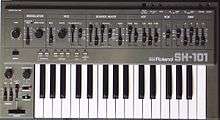Roland SH-101
| SH-101 | |
|---|---|
 Roland SH-101 grey model | |
| Manufacturer | Roland |
| Dates | 1982-1986 |
| Price |
US$495 |
| Technical specifications | |
| Polyphony | Monophonic |
| Timbrality | Monotimbral |
| Oscillator |
1 VCO with 3 simultaneously mixable waveforms : Pulse with PWM, Saw and Sub wave (selectable -1 Oct. Square, -2 Oct. Square or -2 Oct Pulse) The Pulse wave can be modulated by LFO, by Envelope or manually Noise is also available at the oscillator mixing stage |
| LFO |
1 LFO: triangle, square, random and noise waveforms |
| Synthesis type | Analog subtractive |
| Filter |
1 resonant VCF, modulated with ADSR, LFO, keyboard tracking and/or bender controller |
| Attenuator |
ADSR envelope, triggered by gate or LFO |
| Aftertouch expression | No |
| Velocity expression | No |
| Storage memory | 100 step sequencer |
| Effects | Arpeggiator (up, down, up/down) |
| Input/output | |
| Keyboard | 32-note |
| Left-hand control |
Bender assignable to VCF frequency and/or pitch as well as pitch bend and mod wheels on attachable handle |
| External control | CV/Gate |
Roland SH-101 is a synthesizer from the early 1980s, manufactured by Roland. It is a small, 32 key, monophonic analog synthesizer. It features one oscillator with 3 simultaneous waveforms: sawtooth, square/pwm, and an octave-divided square sub-oscillator. It has a low-pass filter/VCF capable of self oscillation. The self oscillation filter can be used to make bass drum sounds. The controls are simple to use as there is a slider or switch available for every single parameter, and there is an external trigger input to control the speed of the sequencer or the arpeggiator. Another unique feature is being able to select noise as a modulation source for both pitch and the filter, resulting in distortion-like effects. External control is achieved using CV/Gate. Delivering a truly analog experience, the SH-101 does not have patch memory and cannot be controlled by MIDI. MIDI implementation can be achieved by using a CV/MIDI Converter. The SH-101 was originally marketed as a monophonic synthesizer for people who are new to synthesizers. Its core attribute is simplicity. The SH-101 can also be battery powered. The SH-101 was produced in three colors: gray, blue, and red. Contrary to legend, the SH-101 never came in white. A shoulder strap can be connected to it, and a small handgrip can be plugged into the side which contains a pitch bend wheel and a pitch modulation trigger. When slung over the shoulder it doubles as a "keytar". The Roland MC-202 MicroComposer, a monophonic analog synthesizer/sequencer released by Roland in 1983 has an almost identical voice architecture to the Roland SH-101, other than the LFO which only features a triangle wave form, and also has a delay.
Software emulation
The popularity of the SH-101 is such that many companies have seen fit to cater to a significant market of musicians who want the sound of the 101 but are not able to pay for one. This has led to a rise in clones—devices designed to emulate the SH-101 for a much cheaper price. Such devices are the "Lush-101" by D16 group, "TAL-BassLine-101" by Togu Audio Line, and "PowerCore 01" for the PowerCore platform.
In 2014, Roland released the AIRA System-1 synthesizer which includes a digital emulation of the SH-101 that could be operated both as software on a computer and directly from the hardware keyboard.
Notable users
The SH-101 was a popular monophonic analog synthesizer that can be seen in many pieces of music, capturing the sound of the 1980s. Artists who have used the SH-101 in their music include Orbital, the Future Sound of London, Überzone, the Prodigy, 808 State, the Grid, Cirrus, Eat Static, Jimmy Edgar, Apollo 440, Devo, Union Jack, Luke Vibert, Dirty Vegas, Josh Wink, the Crystal Method, Aphex Twin, Astral Projection, les Rythmes digitales, Sense Datum, Squarepusher, Sascha Konietzko of KMFDM, Freddy Fresh, Lab-4, Nitzer Ebb, the Chemical Brothers, Boards of Canada, the Moog, and others.